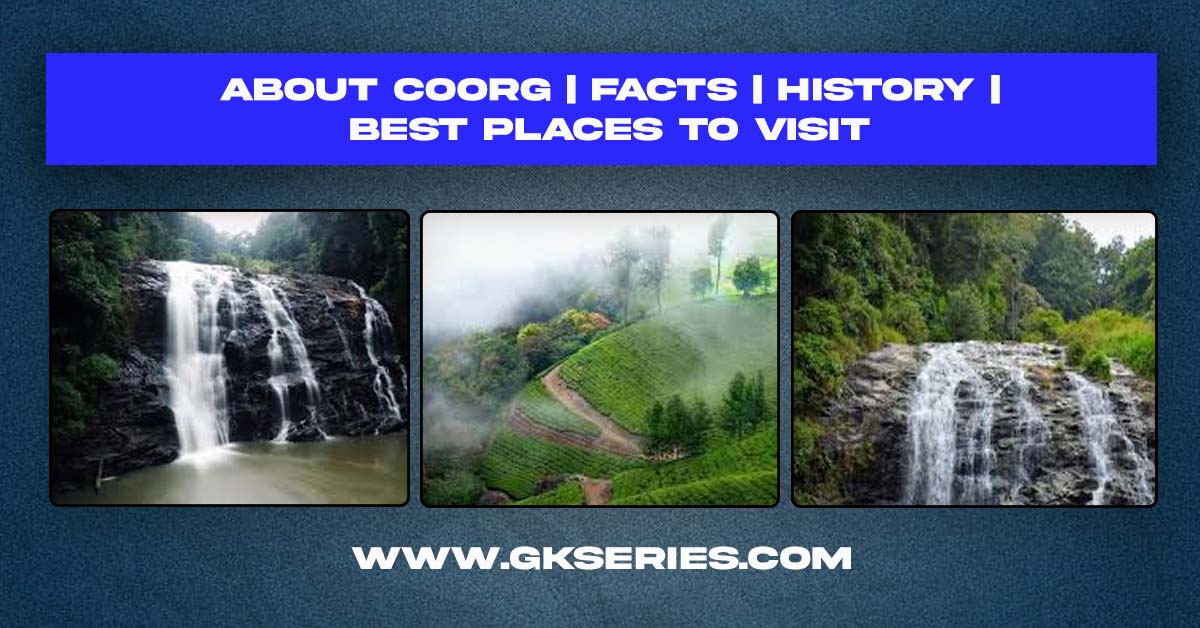
In this article, we provide comprehensive information about the geography, history, population, and top tourist destinations of Coorg. Coorg, also known as Kodagu in Kannada language is a popular hill stations in India. The Coorg district is surrounded by Dakshina Kannada district to the northwest, Hassan district to the north, Mysore district to the east, Kannur district of Kerala to the southwest, and Wayanad district of Kerala to the south. Madikeri serves as the headquarters of the Coorg district.
| About: | Coorg, officially known as Kodagu, is a landlocked district in the State of Karnataka. It covers an area of 4,102 square kilometers, making it larger than the State of Goa. The landscape of Coorg is predominantly hilly, with extensive forests and plantations, particularly coffee, which is a prominent feature of the region. While Kushalnagar town and its surrounding areas are situated in the plains, the majority of Coorg is characterized by its mountainous terrain, featuring hills and valleys that weave through the landscape. The average elevation in Coorg ranges from about 3,000 to 5,000 feet above sea level. This region is rich in biodiversity and has a delicate ecosystem. Notably, three wildlife sanctuaries and one reserved forest in Coorg have been designated as a World Heritage Site by UNESCO. |
| History: | The majority of the early accounts of Coorg(Kodagu) are fundamentally eminent and the genuine record of history in Coorg is available only following the ninth century. On the word of inscriptions, Coorg was under the rule of many dynasties of South India such as Changalvas, Cholas, Gangas, Hoysalas, Kadambas and Pandyas. It is believed that early on the northern part of Kodagu was under the Kadambas and the south under the Gangas. The Cholas were a powerful force in the eleventh century they defeated the Gangas. However, the Changalva Arasus continued o rule the south Kodagu when Raja Chola was ruling in Tanjavur. The northern parts of Kodagu were ruled by the Kongalvas who were a vassal of the Cholas. The situation more or less remained the same till the invasion under Alauddin Khilji. In the fourteenth century the Changalvas became prominent rulers of Kodagu. For most of the period the influence of the Changalvas or the Kongalvas never reached beyond the borders of Kodagu. |
| Topography: | The hilly topography of Coorg is interspersed with grassy downs, paddy fields, sloping glades & gorges & deep valleys across most part of Coorg. |
| Wildlife & Ecology: | Coorg has four main types of vegetation. The Evergreen forests are found in the north and west, while the central and southern regions are home to Moist deciduous and Dry deciduous forests. Nestled between the mountain slopes, you can also find isolated evergreen or Shola forests, which are surrounded by grasslands. The area boasts three wildlife sanctuaries: Brahmagiri Wildlife Sanctuary, Talakaveri Wildlife Sanctuary, and Pushpagiri Wildlife Sanctuary, along with one national park, Nagarahole or Rajiv Gandhi National Park. Pushpagiri, located in the northern part of Coorg, is known for its rare and endangered flora and fauna, earning it a designation as one of the important bird areas in the world. The rich Kadamakkal reserve forest is part of this sanctuary. The name Pushpagiri comes from the highest peak in the region, while Kumaraparvat is another smaller peak nearby. The sanctuary is bordered by the Bisle reserve forest and the Kukke Subramanya forest ranges. |
| Wildlife Sanctuaries in Coorg: | Pushpagiri Wildlife Sanctuary Brahmagiri Wildlife Sanctuary Talacauvery Wildlife Sanctuary |
| National Park in Coorg: | Nagarhole ( Rajiv Gandhi ) National Park |
| Country : | India |
| State: | Karnataka |
| Language: | Kannada Kodava |
| Population: | 554,519 (2011) |
| Literacy rate: | The district has a population density of 135 inhabitants per square kilometre (350/sq mi). Its population growth rate over the decade 2001–2011 was 1.13%. Kodagu has a sex ratio of 1019 females for every 1000 males, and a literacy rate of 82.52%. 14.61% of the population lives in urban areas. |
| Major Attractions to Visit: | Abbey Falls Chelavara Falls Iruppu Falls Omkareshwara Temple Tibetan Monastery / Golden Temple Coorg Talakaveri Temple Nagarahole National Park Harangi Tree Park and Elephant camp Mandalpatti View Point Raja’s Seat Glenlorna Tea Plantation Bhagamandala |





